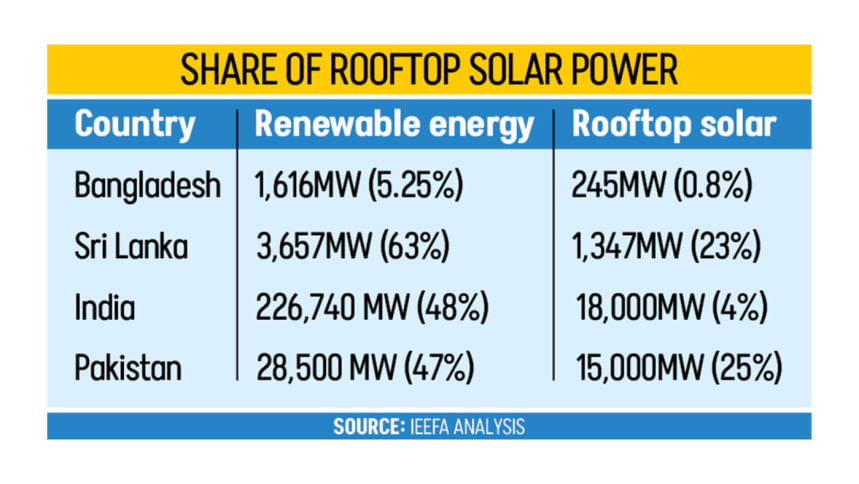Govt’s ambitious rooftop solar target hard to meet: IEEFA

The government's fresh move to roll out a nationwide rooftop solar programme is expected to act as a "push factor" for the country's energy transition, but achieving the target within the stipulated timeframe will be highly challenging, according to a briefing note from the Institute for Energy Economics and Financial Analysis (IEEFA).
The think tank termed the interim government's goal to install 3,000 megawatts (MW) of rooftop solar by December this year as "ambitious," as this sector is still weighed down by problems such as poor quality control, weak regulatory monitoring, high import duties, a cap on installed capacity, and financing bottlenecks.
In its note, Rooftop Solar's Time to Shine in Bangladesh, IEEFA said the success of the new programme will depend on accurately assessing the potential of rooftop solar, strengthening monitoring, and ensuring coordination among different ministries.
In June, the government revised the 2008 Renewable Energy Policy and set a target to generate 20 percent of total electricity from renewable sources by 2030 and 30 percent by 2040. As part of the plan, the government set the rooftop installation target and initiated a national programme.
The new programme proposes using public funds for rooftop solar in government offices under the Capital Expenditure (CAPEX) model. Further, it aims to encourage Engineering, Procurement, and Construction (EPC) companies to invest in rooftop solar projects in hospitals, as well as educational and religious institutions, under the Operational Expenditure (OPEX) model.
However, IEEFA warned that the initiative faces major uncertainties, such as determining the rooftop potential of designated buildings, addressing maintenance issues under the CAPEX model, and recording solar generation during load-shedding.
"Otherwise, due to insufficient information or perceived risks, developers may show only modest interest in government tenders," it said.
Since the first rooftop solar projects in 2008, Bangladesh has installed 245MW in total, 209MW of that between July 2018 and June 2025, averaging just 30MW per year. "To reach the new target in less than six months, installations would need to scale up more than twelve-fold," IEEFA noted.
The briefing also noted that negative perceptions about rooftop solar persist. Limited regulatory oversight has allowed small vendors to supply low-quality panels and accessories, undermining confidence in the technology. Bangladesh also lacks clear guidelines to regulate vendors and EPC companies for both project implementation and long-term maintenance.
HIGH IMPORT DUTIES AND CAPACITY CAP
IEEFA pointed out that high import duties continue to slow down progress. While customs duty on inverters was reduced from 10 percent to 1 percent in June, other essential items such as FRP walkways, mounting structures, and DC cables remain heavily taxed.
Additionally, rooftop solar capacity is capped at 70 percent of an industry's sanctioned load. For example, a factory with a sanctioned load of 1MW cannot install a rooftop plant larger than 0.7MW, regardless of available rooftop space.
"This restriction prevents many industries and commercial buildings from setting up larger plants and maximising savings," the briefing said.
Access to finance is another hurdle. EPC companies struggle to secure loans under the OPEX model, while industries face similar challenges under the CAPEX model. Confusion also persists over whether EPC firms qualify for low-cost central bank green funds.
"Borrowing at commercial rates raises project costs and cuts profits," IEEFA noted.
While rooftop solar offers an attractive return on investment and is often described as a "low-hanging fruit" for Bangladesh's energy transition, IEEFA cautioned that unless quality and monitoring issues are urgently addressed, the sector will continue to fall short of its potential.

 For all latest news, follow The Daily Star's Google News channel.
For all latest news, follow The Daily Star's Google News channel. 









Comments